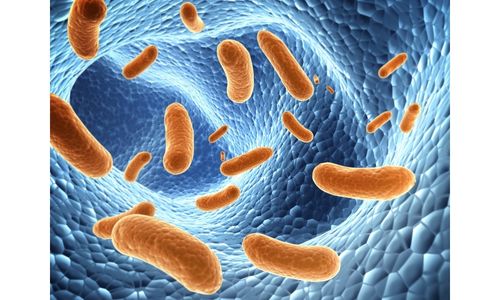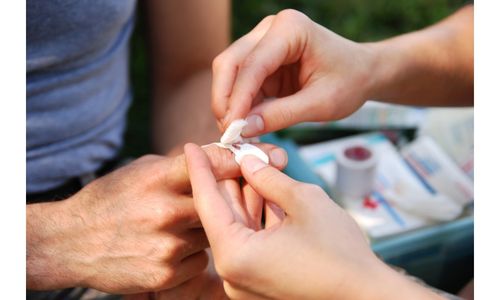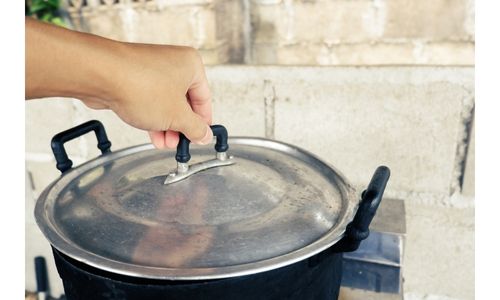
In this world, where we barely have time to cook, it may seem like an impossible task to wash utensils. Because a dishwasher helps us save on water and energy, it can be a boon in the kitchen. However, not everything can be cleaned in the dishwasher.
Are you wondering if you clean your food processor in the dishwasher? Even though the jars and lids are made of plastic, they are dishwasher safe!
This article will address the never-ending debate between dishwashers and handwashing. We will also discuss in detail how to clean the food processor without disfiguring it.
Are Food Processor Parts Dishwashers Safe?

Food processors are designed to save time and revolutionize the cooking experience. Most parts in the food processor are dishwasher-safe. However, it is advisable to dismantle and handwash the parts before placing them for the dishwashing cycle.
Certain parts of the processor, like the motor, cannot be cleaned in the dishwasher. So, if you end up spilling something on the food processor’s motor, you can wipe it with a clean and moist cloth.
How Often Should You Clean a Food Processor?
The best bet is to wash it after every use. However, submerge the processing jar and blades in the water if you are occupied. It ensures that the ingredients don’t adhere to the jar and the blades, thus making cleaning easier.
If the bowl is not cleaned thoroughly, it will accumulate moisture and ingredients and over time leave a stain behind. If you leave it over the counter for a long, there is a possibility that fungus and other microbes may colonize it since it is rich in nutrients and is also humid.
What Parts of Food Processors are Dishwasher Safe?

In most cases, washing the jars and lids in a dishwasher is okay. The blades in the processor can also be cleaned safely without any damage in a dishwasher.
Since the heating coils are located at the bottom of the dishwasher, it is advisable to place the parts there to prevent heat damage. Furthermore, because the jars are made of plastic, exposure to intense heat may change their appearance and render them useless.
Cleaning in the Dishwasher
If you are someone who doesn’t like washing utensils and jars with your hands, a dishwasher is a boon in your kitchen! Not only does it save time, water, and energy, but it is also kinder to your hands.
However, everything has advantages and disadvantages. In this section, let us explore the pros and cons of washing the parts of a food processor in a dishwasher.
Dishwasher Pros
Ease of Cleaning
In this era where we are juggling multiple deadlines, leisure time, and family time, there is no time left for washing utensils. So a dishwasher is a practical appliance that can clean our dishes and other items without us standing at the sink and scrubbing them after cooking meals.
A food processor is often used to prepare meals and salads. The blades and jars may vary depending on the menu you have decided. Thus, by the time the meal is through, you can have a lot of jars and blades that need to be washed.
Hence, the luxury of tossing them in a dishwasher is something that cannot be denied.
Free from Pathogens

Since dishwashers clean with the help of heating elements, the temperature of the water used inside the machine for cleaning is very high. At such high heat and temperature, microbes and pathogens cannot survive. Thus, it not only cleans but also sterilizes the parts of the food processor.
Often, we grind raw meat or fruits in the processor, and the microbes present in them can colonize and directly affect the individual’s health.
Since dishwashers can eliminate the threat of infection, it is a better option than hand washing.
Eliminates Moisture
A big task after washing utensils is drying them. It may take hours for something to get air-dried. Air coupled with high moisture can cause the growth of molds and fungus.
In dishwashers, the washing cycle is coupled with drying cycles. Thus, the vessels and equipment are clean and dried efficiently to prevent moisture accumulation.
Dishwasher Cons
Time-consuming

Many believe using a dishwasher to wash items expedites the task. It is true if you have a large family and frequently use utensils during meal preparation and consumption.
However, in a small family, the number of utensils needing washing is relatively few. Since, generally, dishwashers are started when the load is full, for small families, one may have to wait for a couple of days to clean their utensils.
Imagine not having fruit processing jars for two days. Hence, cleaning dishwashers can be time-consuming.
Baking leftovers
If you directly load the food processing parts in the machine without pre-rising them, it can cause issues. For instance, if there are any leftovers in the jar, the dishwasher will heat them. As the leftover is baking or cooking, it may emit a burning smell.
Hence, food processors can also be added to the dishwasher after it has been rinsed to remove the leftovers.
Hot Temperature

The temperature inside the dishwasher is responsible for sterilizing the dishes and devices while cleaning them. The plastic jars and rubber gaskets can melt and change at high temperatures.
Furthermore, high heat can damage the processor blade and make them blunt. Since the heat released is also high, it can increase the room’s overall temperature.
Handwashing
Handwashing gives a satisfaction that is often understated. Dishwashers can be fun, but if you want to grind multiple purees and smoothies on the same day, washing them right away is the best bet!
Let’s look at the advantages and disadvantages of handwashing the food processor.
Handwashing Pros

Target Every Spot
Dishwashers are machines, and hence there is a possibility that even the most powerful jet may not be able to clean the tough spots and narrow crevices.
However, with handwashing, this can be completely under our control. One can pay attention to the tiniest crooks and clean them thoroughly without leaving any leftovers behind.
It also helps improve the equipment’s life span since it is not subjected to high heat.
Gentle Wash
The soaps used in a dishwasher are harsh and can cause abrasion on plastic items; hence, they can damage the jars and lids of the food processor.
The soap we use for handwashing is milder and can clean the processor parts without defacing them.
Availability
Well, unless the entire dishwasher is not loaded, usually, the cycle will not start. Hence, if you want to clean the food processing unit in a dishwasher, you will have to wait for the cycle to get completed before being able to use it.
Contrary to that, if you hand wash them, they can be wiped and used right away without any wait time. Hence, you can reuse the unit multiple times throughout the day by handwashing it.
Handwashing Cons
Injuries

It may not surprise you, but the blades used in the food processing units are razor-sharp to cut through even the toughest of fruits and vegetables. Every year, more than 350,000 people get injured due to these knives.
These metal blades need to be handled with care to prevent cutting yourself. You may want to avoid washing these blades with your hands if you are clumsy.
Additional Chore
According to Energy Star, Using a dishwasher for a year reportedly saves you an average of 230 hours of physical effort, which is over ten days!
Hence, if you are busy and cannot spend time cleaning dishes, you can opt for dishwashing the processor rather than hand washing them.
Cleaning Gadgets
Since cleaning them with hands can also be tricky, one may have to invest in special brushes and sponges to clean the food processor.
Using a regular sponge that is abrasive can damage the jar and lids and cause scratches and tear-offs. It will further result in leakage and mold.
Even the blades can get blunt if rubbed with a harsh surface. Hence, mild sponges and mild detergents should be employed while handwashing the food processor parts.
Proper Handwashing
If you don’t cook often, and if the utensils released are limited, setting up a dishwasher will not be worth it. In such situations, handwashing can help you save water and time.
However, washing the parts of the food processor can be very challenging. Hence, one needs to know how to clean them thoroughly without hurting themselves or the processing unit due to sharp edges.
Your Blades

Dipping the blades in warm water is the best way to wash them. In the warm water, add 1 -2 pumps of the dishwasher and a tablespoon of baking soda.
After this, you can use a soft sponge and rinse the blade. While cleaning it, make sure you clean from the center and move your way outwards. It will prevent injuries from the sharp blade and help keep their sharpness intact.
While cleaning blades, don’t use very hot water or harsh chemicals because it can damage them and reduce their efficiency over time.
The Bowl and Its Lid

Rather than directly washing the bowl and lid under running tap water, you can wash it after running it with soap water.
In the bowl, add water and 2-3 pumps of dishwashing soap. Close the lid and run the processor for 2 to 5 minutes. It will result in cleaning the leftover ingredients from the corners and lid to facilitate better cleaning.
Now, open the unit and wash it with the help of a sponge under running tap water.
Drying
Unlike dishwashers that run a drying cycle, in handwashing, you need to dry the dishes manually after washing them.
Leaving the lid, blade, or bowl wet after washing will promote the growth of bacteria, fungi, and other microbes. Hence, when the cleaning is done, one must use a clean and dry towel to wipe off the moisture.
How long should a food processor last?
Every food processor comes with a warranty period, but if the machine is good and the motor is heavy duty, the unit can last way more than the warranty period. Some units are decades old and are still doing fine. The ideal life span of a food processor is 4-7 years.
However, since food processors are used frequently, they may need maintenance from time to time to fix performance issues. For instance, due to kitchen use, the blades may get blunt and not work as efficiently as before; in such situations, the blades may need replacement or occasional sharpening.
FAQ
1: Is it hard to clean a food processor?
Answer: Cleaning food processors is easy; however, it can be challenging when cleaning with your hands since the blades are sharp and can cut through the skin. However, with the right technique and equipment, it can be avoided.
2: Is distilled white vinegar for cleaning?
Answer: Yes. The processor frequently leaves stains and odors behind because it grinds various ingredients. Distilled white vinegar can be used for 20 minutes to help with stain removal and odor control. Just put the vinegar in the container and spin it for five minutes. Then let it sit for 20 minutes before rinsing it with lukewarm water.
3: Can I put my Cuisinart blender in the dishwasher?
Answer: The Cuisinart blender is dishwasher safe. Hence, the lids, bowls, and blades can be placed on the top rack of the dishwasher for intensive cleaning.
Takeaway
Food processor parts can be washed safely in a dishwasher. However, since the soaps used are harsh and the heat produced is intense, it can damage the equipment over time. However, it saves time and effort!
In contrast, handwashing can be very convenient and clean thoroughly without causing any abrasion, but it is time-consuming and may not be fun if you end up hurting yourself with the sharp blades.
I hope you found this article helpful. If you have any further queries, feel free to ask in the comment section.



